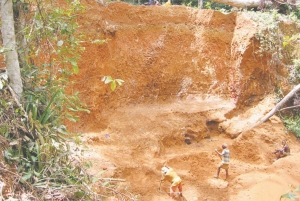If a merger between African Aura Resources (AAZ-V) and Mano River Resources (MNO-V, MNRVF-O) goes ahead, the combined company will have close to $10 million in cash, an advanced-stage, high-grade gold project and a well-funded iron ore project, both in Liberia, and some promising gold and iron exploration projects in Cameroon.
Mano River is offering 1.57 of its shares for each African Aura share. African Aura shareholders will meet on July 31 to vote on the merger. Management of both companies hope to close the deal by September.
“Combining Mano’s cash with ours gives the combined group more firepower to go after further acquisitions and mergers,” John Gray, African Aura’s president and chief executive told The Northern Miner in a telephone interview from his home in London. “The combined cash is good backing for Mano’s plans to put the New Liberty gold deposit in western Liberia into production.”
Once the merger goes ahead, the priority will be to build a mine at New Liberty, 100 km northwest of Monrovia, Gray said. The deposit has a measured and indicated resource of 13.5 million tonnes grading 3.18 grams gold per tonne for 1.4 million contained ounces gold.
“It’s not a huge mine, but it’s an Archean-hosted one,” Gray noted. “It will be a relatively low-cost, underground mine, mining high grade. That’s the priority and there will probably be a financing to come with that.”
Mano holds 100% of New Liberty, subject to a 10% free-carried interest and a 3% production royalty, both held by the government of Liberia.
When the project is complete, it will be Liberia’s first-ever major hard-rock gold mine. Mano obtained the licence in 1997 but it could not work peacefully in the war-torn country until 2004.
Liberia is considered a more attractive investment destination today under President Ellen Johnson- Sirleaf, the first elected female head of state in Africa.
The second priority of the combined company will be to develop Mano’s Putu iron project in southeastern Liberia, which the company believes has “seriously attractive export volume.” Severstal Resources holds 61.5% of the project, while Mano holds the remaining 38.5%.
The two companies are advancing Putu, a banded iron formation deposit, towards a resource estimate and a prefeasibility study in the second half of 2010.
This year, a multi-rig, 27,000- metre diamond-drill program is planned.
In a statement in March, Mano CEO Luis da Silva said that despite depressed commodity prices, the outlook for steel and iron ore demand was “gradually improving,” adding that he looked forward to a very different market environment by late 2012, “by which time the Putu project should be looking for funding in order to develop in advance of production in 2015.”
Gray of African Aura describes the Putu project as a “big beast” and “favourably situated” about 120 km from the coast. “They will have to put a rail line in, but it’s a downhill run all the way to the coast and they are well supported by Severstal,” he says.
For its part, African Aura has a portfolio of exploration licences spread over 9,480 sq. km of sub- Saharan Africa.
The junior explorer is focused on discovering economic iron, gold, and uranium deposits and its flagship projects include the high-grade Batouri gold project in eastern Cameroon, the 12-km-long Nkout iron project in southern Cameroon and the Fula gold project in western Liberia.
Gray notes that the company is getting “interesting results” at Batouri and is embarking on a second exploration phase at its Nkout project.
“We’re about three years behind Mano in terms of development, but what we have in Cameroon is a country that has never been explored, with excellent geology, good infrastructure and a bright future,” Gray explains. “They’ve never tried before and we’re the first people to stay there and have a go if you like.”
Indeed, Cameroon did not have a developed mining program until 2001, when the World Bank helped the country put a mining code in place.
“They had oil, so the powers that be weren’t particularly interested in mining because it was small money whereas oil was big money,” Gray elaborates. “Now they’re running out of oil so they have got to find something to replace that income. And they’ve woken up to the fact that they have good geology — Archean geology.”
Cameroon, twice the size of Ghana, has got enough geographical cover to contain diverse geological domains on which to capitalize, Gray added.
“I see Cameroon as a second Mali,” he said. “I don’t see it as a Ghana in terms of gold production, but comparable to some Malian and Burkina Faso-sized gold projects, so that’s what we’re looking to do there.”
In addition to the obvious synergies between the two companies, the combined board will have more reach and experience than the two separate boards had, Gray says, adding that African Aura’s Canadian investors will complement Mano’s largely European shareholder base.
African Aura currently trades at about 8¢ per share and has a 52- week trading range of 2.5-39¢ per share with 55 million shares outstanding.
Mano River is trading at about 7¢ per share and has a 52-week trading range of 1-21.5¢ with 317.8 million shares outstanding.


Be the first to comment on "Mano River Makes Friendly Bid For African Aura"